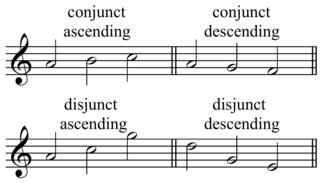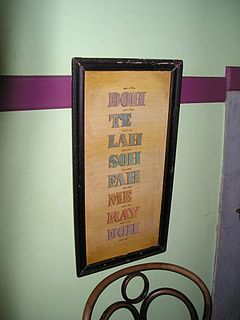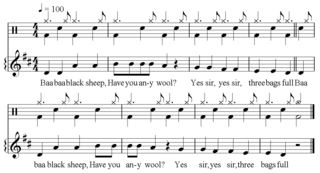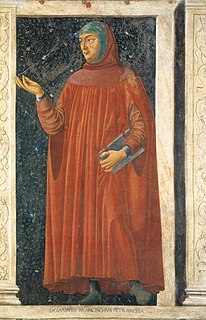
Music notation or musical notation is any system used to visually represent aurally perceived music played with instruments or sung by the human voice through the use of written, printed, or otherwise-produced symbols.
In music theory, the term minor scale refers to three scale patterns – the natural minor scale, the harmonic minor scale, and the melodic minor scale – rather than just one as with the major scale.
In music theory, a scale is any set of musical notes ordered by fundamental frequency or pitch. A scale ordered by increasing pitch is an ascending scale, and a scale ordered by decreasing pitch is a descending scale. Some scales contain different pitches when ascending than when descending, for example, the melodic minor scale.
Plainsong is a body of chants used in the liturgies of the Western Church. Though the Catholic Church and the Eastern Orthodox churches did not split until long after the origin of plainsong, Byzantine chants are generally not classified as plainsong.

Gregorian chant is the central tradition of Western plainchant, a form of monophonic, unaccompanied sacred song of the Roman Catholic Church. Gregorian chant developed mainly in western and central Europe during the 9th and 10th centuries, with later additions and redactions. Although popular legend credits Pope Gregory I with inventing Gregorian chant, scholars believe that it arose from a later Carolingian synthesis of Roman chant and Gallican chant.
A grace note is a kind of music notation denoting several kinds of musical ornaments. It is usually printed smaller to indicate that it is melodically and harmonically nonessential. When occurring by itself, a single grace note normally indicates the intention of an acciaccatura. When they occur in groups, grace notes can be interpreted to indicate any of several different classes of ornamentation, depending on interpretation.
An appoggiatura is a musical ornament that consists of an added non-chord note in a melody that is resolved to the regular note of the chord. By putting the non-chord tone on a strong beat, this accents the appoggiatura note, which also delays the appearance of the principal, expected chord note. The added non-chord note is typically one degree higher or lower than the principal note; and if lower, it may be chromatically raised. An appoggiatura may be added to a melody in a vocal song or in an instrumental work.
Chromaticism is a compositional technique interspersing the primary diatonic pitches and chords with other pitches of the chromatic scale. Chromaticism is in contrast or addition to tonality or diatonicism. Chromatic elements are considered "elaborations of or substitutions for diatonic scale members".
Chromaticism is almost by definition an alteration of, an interpolation in or deviation from this basic diatonic organization.
Emilio de' Cavalieri, or Emilio dei Cavalieri — the spellings "del" and "Cavaliere" are contemporary typographical errors — was an Italian composer, producer, organist, diplomat, choreographer and dancer at the end of the Renaissance era. His work, along with that of other composers active in Rome, Florence and Venice, was critical in defining the beginning of the musical Baroque era. A member of the Roman School of composers, he was an influential early composer of monody, and wrote what is usually considered to be the first oratorio.

Melodic motion is the quality of movement of a melody, including nearness or farness of successive pitches or notes in a melody. This may be described as conjunct or disjunct, stepwise, skipwise or no movement, respectively. See also contrapuntal motion. In a conjunct melodic motion, the melodic phrase moves in a stepwise fashion; that is the subsequent notes move up or down a semitone or tone, but no greater. In a disjunct melodic motion, the melodic phrase leaps upwards or downwards; this movement is greater than a whole tone.
In popular Western music, a melodic leap of disjunct motion is often present in the chorus of a song, to distinguish it from the verses and captivate the audience.
A false relation is the name of a type of dissonance that sometimes occurs in polyphonic music, most commonly in vocal music of the Renaissance.
The term describes a "chromatic contradiction" between two notes sounding simultaneously in two different voices or parts; or alternatively, in music written before 1600, the occurrence of a tritone between two notes of adjacent chords.
In music, a sequence is the restatement of a motif or longer melodic passage at a higher or lower pitch in the same voice. It is one of the most common and simple methods of elaborating a melody in eighteenth and nineteenth century classical music. Characteristics of sequences:

Musical improvisation is the creative activity of immediate musical composition, which combines performance with communication of emotions and instrumental technique as well as spontaneous response to other musicians. Sometimes musical ideas in improvisation are spontaneous, but may be based on chord changes in classical music and many other kinds of music. One definition is a "performance given extempore without planning or preparation." Another definition is to "play or sing (music) extemporaneously, by inventing variations on a melody or creating new melodies, rhythms and harmonies." Encyclopædia Britannica defines it as "the extemporaneous composition or free performance of a musical passage, usually in a manner conforming to certain stylistic norms but unfettered by the prescriptive features of a specific musical text. Improvisation is often done within a pre-existing harmonic framework or chord progression. Improvisation is a major part of some types of 20th-century music, such as blues, jazz, and jazz fusion, in which instrumental performers improvise solos, melody lines and accompaniment parts.

Tonic sol-fa is a pedagogical technique for teaching sight-singing, invented by Sarah Ann Glover (1785–1867) of Norwich, England and popularised by John Curwen who adapted it from a number of earlier musical systems. It uses a system of musical notation based on movable do solfège, whereby every tone is given a name according to its relationship with other tones in the key: the usual staff notation is replaced with anglicized solfège syllables or their abbreviations. "Do" is chosen to be the tonic of whatever key is being used. The original solfège sequence started with "Ut" which later became "Do".
Polish organ tablatures include some of the earliest and most important tablature sources of instrumental music in Europe. Particularly well-known is the Jan z Lublina tablature, which dates from mid-16th century and contains some 250 pieces. Most Polish organ tablatures use the German form of notation. The genres vary from all kinds of liturgical music to dances and vocal intabulations. This article presents a partial list of Polish organ tablatures, in chronological order.

Diatonic and chromatic are terms in music theory that are most often used to characterize scales, and are also applied to musical instruments, intervals, chords, notes, musical styles, and kinds of harmony. They are very often used as a pair, especially when applied to contrasting features of the common practice music of the period 1600–1900.
B♭ is the eleventh step of the Western chromatic scale .
It lies a diatonic semitone above A and a chromatic semitone below B, thus being enharmonic to A♯, even though in some musical tunings, B♭ will have a different sounding pitch than A♯. B-flat is also enharmonic to C.

Carnatic raga refers to ragas used in Carnatic music. A Carnatic raga has several components - primordial sound (nāda), tonal system (swara), pitch (śruti), scale, ornaments (gamaka) and important tones.
Symphony No. 3 is a symphony for orchestra in five movements composed between 1988 and 1995 by Krzysztof Penderecki. It was commissioned and completed for the 100 year celebration of the Munich Philharmonic. Its earliest version, Passacaglia and Rondo, premiered at the International Music Festival Week in Lucerne, Switzerland, on August 20, 1988. It was performed by the Lucerne Festival Orchestra and conducted by Penderecki. The full symphony premiered in Munich on December 8, 1995, and performed by the Munich Philharmonic, again under the composer's baton.

In music, prosody is the way the composer sets the text of a vocal composition in the assignment of syllables to notes in the melody to which the text is sung, or to set the music with regard to the ambiance of the lyrics.











